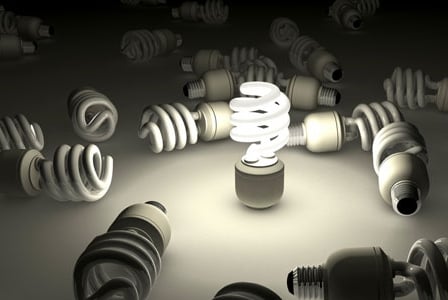
With the push to ditch incandescent light bulbs in favour of mercury-containing compact fluorescent lamps (CFL), Canada may not have an adequate mercury waste plan.
A new report commissioned by Environment Canada points to real problems across the country when it comes to mercury waste disposal. The Canadian Press is reporting the study, commissioned from Summerhill Impact and dated August 2012, points to either patchwork or non-existent mercury-waste facilities across the country.
Why worry?
The irony is that the Canadian government has plans to scrap the energy-inefficient incandescent light bulb in favour of more energy efficient bulbs such as mercury-containing compact fluorescent lamps (CFL), though the phase out date was quietly moved forward to January 2014 from January 2012.
Though they\’re not a problem unless the glass is broken; and not that there’s a large amount of mercury inside; but when you consider that CFL bulbs need to be discarded safely because of the mercury that will inevitably seep out once thrown out, we may be woefully unprepared. (But maybe the federal government had an inkling of this when they postponed the phase out of the incandescent bulb.)
Are we ready?
A double irony lies in the fact that Canada has been involved (along with 139 other countries) in creating the Minamata Convention, a global mercury agreement meant to control mercury pollution levels around the world. The agreement was so-named after the Japanese city where at least 50,000 residents were affected by mercury poisoning from eating local shellfish that had been contaminated by industrial pollutants.
The convention aims to phase out mercury-containing products such as batteries, some soaps and cosmetics, and thermometers by 2020, while the major contributors to environmental mercury levels such as coal-fired power stations and small-scale gold mining will be held to stricter rules.
What can you do?
Of course, there is only so much an individual can do to limit their exposure to mercury or to avoid adding to the global mercury pollution levels, but we can each contribute in small ways.
Avoid buying products with mercury
- Fluorescent bulbs—both CFL bulbs and other fluorescent bulbs contain mercury, but some brands contain less. Look for those labelled low mercury.
- Thermometers—old thermometers (with the silver liquid) are not readily available anymore. Look for digital, alcohol (usually a red liquid), solar, or card thermometers.
- Thermostats—older round thermostats have a mercury switch inside, though most newer digital thermostats are mercury free.
- Button-cell batteries—found in wrist watches, hearing aids, and calculators. Look for electrical devices where possible.
Limit the amount of certain types of seafood
Though seafood provides a wealth of beneficial nutrients, some fish may also contain much higher levels of mercury, a result of mercury pollution that has entered their ecosystem. Because mercury poses significant health risks to fetuses, young children and women who are pregnant should be especially careful about the amount and types of fish they eat.
According to Health Canada, the following fish are likely to contain more mercury and should be eaten in moderation:
- fresh/frozen tuna (canned is fine)
- shark
- swordfish
- marlin
- orange roughy
- escolar (also called snake mackerel, oilfish, rudderfish)
Discard mercury-containing products safely
If your fluorescent bulbs have kicked the bucket, throwing them in the bucket is a no-no. Considered hazardous waste, mercury-containing products, such as CFL bulbs or fluorescent tubes, must be disposed of properly to avoid releasing mercury into the environment.
The first step is to wrap your old bulbs carefully in a plastic bag (a box is even better) to avoid breakage while you transport them to a safe disposal facility. At the moment, disposal sites are haphazard, but Environment Canada provides a list of regional or municipal contacts where you can get more information about how to dispose of your mercury-containing products safely.
























